When Japanese artist Chiura Obata arrived in the United States in 1903, he brought an immigrant’s dream to make it in America. And, eventually, he did; Obata become an esteemed professor at the University of California, Berkeley, and created gorgeously rendered brush and ink portraits of his adopted homeland that place him firmly in the canon of great American landscape artists.
But the journey was not easy. Obata (1885-1975) was among the 120,000 to be imprisoned in squalid Japanese-American incarceration camps during World War II. The 11-month internment, surprisingly, did not dampen his love of America, but it changed the essence of his art.
The 150-work retrospective, “Chiura Obata: American Modern,” has made its final stop of an international tour at the Smithsonian American Art Museum with new pieces from the museum’s collections added, including the 1927 watercolor Carl Inn , depicting a tiny cabin nestled in a thick sequoia grove in Yosemite National Park—one of Obata’s favorite haunts.
In 1928, Obata embarked on a project with the Takamizawa Mokuhansha print workshop in Tokyo to recreate some of his watercolors, including Carl Inn, as woodblock prints. The team of 32 carvers and 40 printers managed by Obata, created some 130 proofs, experimenting with ink values, color gradation, light and dark. Many of the woodblock prints were lost or destroyed, as Obata sought to select just one to create his limited edition of 100 prints. But 15 are on display in the show. They are nothing like rough drafts. “Each one of these prints is a triumph, a masterpiece,” says Crawford Alexander Mann, III , the American Art Museum's curator of prints and drawings.
The prints also demonstrate Obata’s painstaking perfectionism and his signature style of blending American and Japanese traditions.
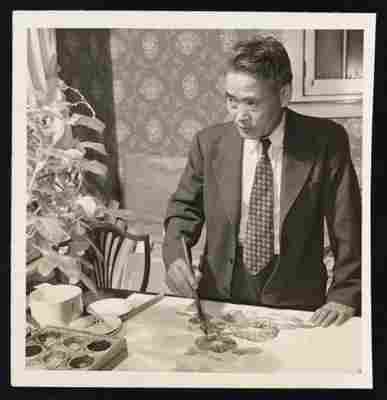
Obata was a prodigy—exquisite color ink studies of purple blossoms and a lily stem, from roots to flower, from his 1890s grade school practice book is on display in the show. The Okayama, Japan, native may have come by his talents naturally. Obata’s father was a painter and drawing instructor at a local high school. Headstrong, the young Obata ran away from home to study art in Tokyo at age 14. By 17, the rising artist had won his first major award, and was being solicited to paint for magazines and books.
In Tokyo, Obata was trained in the classical method of sumi-e (meaning black ink painting), widely used in Japanese and Chinese art. Obata said in 1935 that black ink or sumi allows the expressions of elegance and life, which he called the “central aim of the Japanese and Chinese art.” Obata noted that the art form “gives us an elegance even in a drop or a brush of sumi by which an artist can express himself of things he happens to get in touch with.”
But Obata wanted to break out of what he felt was a constrained existence. He wanted to go to America, “to come in contact with a larger Great Nature,” said Obata when he was interviewed in 1965.
He immigrated to the U.S. in 1903, knowing no one and having no work. Obata found room and board as a domestic helper and began to learn English and to take art classes. Japanese newspapers hired him as an illustrator, and he painted many scenes of San Francisco, including many following the 1906 earthquake.
Though he fell in with other Japanese immigrants, he was not insulated from prejudice. One day in 1907 he was painting a streetscape and was jeered and spit on by a crew of construction workers. Obata decided to take them on. Ultimately, he was arrested for hitting one over the head with a piece of iron. But the judge declared him not guilty of attempted murder. The judge thought it wasn’t a fair fight. Obata was “facing eight guys who were all huge, whereas I was only 135 pound, five feet four inch and a half and occupation painter,” recounted Obata.
Obata began meeting other Japanese-American artists and also found greater success as an illustrator for Japanese publications and companies. In 1909, when he was 24, Gumps hired him to create murals throughout the landmark San Francisco department store.
He founded the East West Art Society in 1921 to trade ideas and organize exhibitions, and “to promote the idea that San Francisco and the arts community there would have something to offer to the rest of the nation and the world through this intersection of artists and visual languages and backgrounds and traditions,” says Mann.
Throughout his career, Obata showcased his mastery of traditional Japanese subjects, such as the deftly-inked 1930s still-lifes of Ikebana flower arrangements on display in the exhibition. His wife, Haruko, was a gifted arranger and author of a 1940 handbook on the art—illustrated, of course, by her husband.
There is no doubting Obata’s sumi-e skills in the 1930s animal series in the exhibition. Untitled (Ibex) is a study of grace and motion. The two leaping animals seem both earthly and ethereal.
But it was landscape that fascinated Obata and is also his greatest legacy, says Mann.
His love of the Sierra Nevadas was first kindled during a six-week visit to Yosemite in 1927, during which Obata created some 150 watercolor sketches. “This experience was the greatest harvest for my whole life and future in painting,” Obata later told the Japanese reporter. He venerated the area so much that he incorporated water from the lakes and streams into his paint pigments.
In 1928, when his father died, Obata returned to Japan and embarked on the project that established him as a modernist and brilliant artist, says Mann. Obata said he took his sketches to the Japanese print makers because he “wanted to preserve this art and I thought it was a good idea to reproduce the impression I had of the High Sierra into woodblock prints.”
The fruits of Obata’s passion can be seen in the 1930 masterwork Lake Basin in the High Sierra , the first print to be completed. Obata described his experience of being at the lake—perched at the foot of Johnson Peak—as near-mystical. He said he heard music that “sounded like the wind and it didn’t sound like the wind” while “the heart of the lake was still.”
The print is photographic in evoking the landscape but it is not flat; it draws the viewer in to experience the setting as Obata did.
Evening Glow at Mono Lake, from Mono Mills (1930) has a similar quality. It’s impossible to believe it’s a woodblock print. Obata described being at the lake to his wife: “A mysterious feeling overwhelmed us. It was beyond description.”
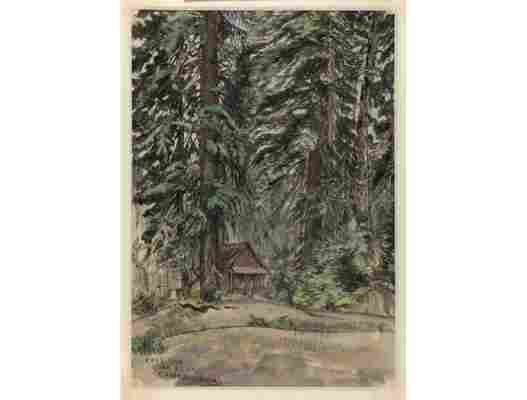
Obata’s landscapes soon drew him many fans—in Japan, and in the Bay Area, where he had solo exhibitions at the California Palace of the Legion of Honor, and at Berkeley. The university asked him in 1932 to give lectures, making him one of the first Asian-American artists to teach there, says Mann. He taught sumi-e and painting on silk, and eventually instructed some 10,000 students over a two-decade career.
It was not just about mastering a brush stroke. “I always teach my students beauty,” said Obata in the late 1930s. “No one should pass through four years of college without being given the knowledge of beauty and the eyes with which to see it.”
Obata was finally where he had dreamed of being: a professional artist, sharing his love of craft and beauty with others. But World War II delivered a rude awakening. After the Japanese bombed Pearl Harbor, Obata and his family—like thousands of other Japanese—were rounded up and sent off to internment camps.
On April 30, 1942, Obata, his wife and three of his four children (one son escaped by transferring from UC Berkeley to Washington University in St. Louis), were sent to live in the stables at the Tanforan Racetrack in San Bruno, California, where some 8,000 Japanese were being forcibly held. Obata and his family were forced to give up an art store and studio they owned in Berkeley, an art store in Oakland, and all of their belongings except what they could pack in a suitcase.
He wanted to do something to show that while humiliated, he and his countrymen were not emotionally defeated. Within a month, Obata got permission to open an art school at the prison camp.
Obata and his family were soon moved to the Topaz War Relocation Center on a forlorn dusty piece of land in central Utah. He brought the art school with him and later said that during his 11 months in the camps he made some 350 paintings. Many, such as Examination Time , depicting newcomers herded into a room to be checked over, showed the daily drudgery and humiliations endured by the prisoners.
At Topaz, for an unknown reason, Obata was attacked by another camp resident and needed to be hospitalized. The April 4, 1943 sketch At Topaz Hospital , depicts what looks like a typical American hospital ward, complete with a Life magazine laid out on a bed. Was this a message? Maybe that internees were no different than Americans?
Some of the prison-era works reflected Obata’s undaunted love of landscape. In Topaz War Relocation Center by Moonlight (1943), the moon—hanging in a melancholy gray-blue sky—casts its light over a handful of low barracks buildings.
The paintings at Tanforan and Topaz were “my way of showing my gratitude to nature,” and a way of keeping himself grounded in hope, Obata said in the 1965 interview. “If I hadn’t gone to that kind of place I wouldn’t have realized the beauty that exists in that enormous bleakness,” he said.
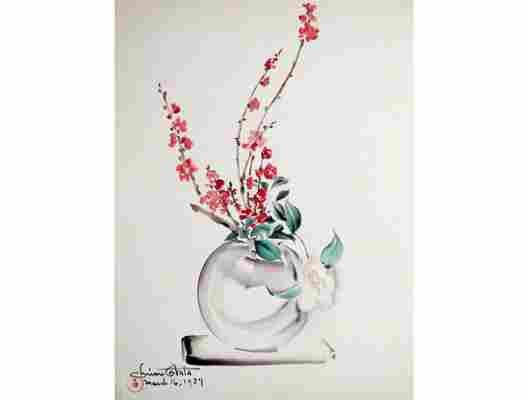
The prison attack served as Obata’s gateway out—allowing him to petition for early release, which he received a month later. Because the Bay Area was still hostile to Japanese, the family moved in with Obata’s son in St. Louis.
It was a relief. The sentiment was reflected in the pastoral Webster Groves, Missouri (1943) of two figures sitting in Adirondack chairs on a grassy lawn, facing a neat, white wood-sided house set among Mimosa trees and ferns.
Obata was reinstated by Berkeley in 1945. A period of reconnecting with nature and sharing his joy of beauty and art with students followed.
He also led dozens of post-War cultural tours to Japan. Obata always took his tour participants to the Hiroshima Peace Memorial Museum, which displays artifacts and photos documenting the August 1945 American atomic bomb attack that killed 100,000. To him, the resilience seen among the burn victims in the photographs spoke to the power of love. “Even the atomic bomb cannot beat them,” Obata said.
The bombing shook him. Just a day after the attack, Obata conceived a trio of paintings. Devastation (1945) shows two figures in the center of a bleak swirl of browns and blacks; it looks like a flattened mushroom cloud. In Prayer (1946), a blackened figure wearing a red cape leans on a walking stick, in a black and brown landscape devoid of flora, fauna or structures. In Harmony (1946), a patch of green grass grows amidst the blackened ground, while two figures, outside a patched shack, appear to be bowing towards the new life.
The war and internment were never far from his mind, and likely changed his art forever, says Mann. “When I look at his work after he was in the camps, after World War II, I see a lot more emotion,” he says, adding that Obata’s later pieces are more directly symbolic.
Beauty of Struggle (1953), a breathtaking four-panel screen measuring six-by-eight feet, is most evocative of Obata’s fusion of self with nature. The oil and gilding on silk depicts a gnarled cypress growing out of a pile of rocks. It is heavily Asian-inflected, but also a realistically modern American landscape.
“I have been working towards this painting in the past forty years,” said Obata, in a 1953 letter about the screen. The painting is of Obata’s impression of the land between Carmel and Point Lobos in California, where, he wrote, “windblown, aged cypress [trees] stand among moss-covered rocks throughout pure white sand dunes [that] meet [the] deep blue Pacific Ocean.”
The screen shows Obata “thinking very directly about the hardships of his life…and about how art-making has helped him get through all those experiences,” said Mann.
Obata continued at Berkeley until 1954 when he retired as professor emeritus. It was the same year that he became a U.S. citizen. His many years in America taught him much about the country. “It goes without saying that America is very rich in natural resources,” said Obata in 1965. “In other words, natural blessings.”
“In many ways America is largely wasting what nature is providing us,” he said. By being more aware, “America has the potential to grow further in the future, and America will become a good nation with true leadership in the world.”
Currently, to support the effort to contain the spread of COVID-19, all Smithsonian museums in Washington, D.C. and in New York City, as well as the National Zoo, are temporarily closed. Check listings for updates. “Chiura Obata: American Modern,” curated by ShiPu Wang , was scheduled to remain on view through May 25, 2020 at the Smithsonian American Art Museum.
This New Dye Changes Color When Exposed to UV Light
Do you love those shoes but can’t decide whether to buy the brown or the blue?
In the near-ish future, you may not have to decide.
A new technology from MIT’s Computer Science and Artificial Intelligence Laboratory (CSAIL) uses reprogrammable ink to change the color of ordinary objects. The system, dubbed “PhotoChromeleon,” uses photochromic dyes that change color when exposed to UV light.
“This special type of dye could enable a whole myriad of customization options that could improve manufacturing efficiency and reduce overall waste,” says CSAIL postdoctoral researcher Yuhua Jin, in a press release . “Users could personalize their belongings and appearance on a daily basis, without the need to buy the same object multiple times in different colors and styles.”
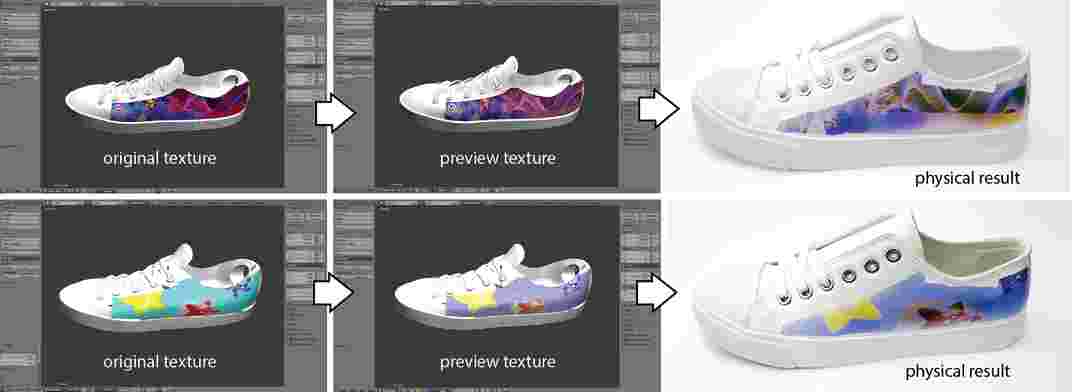
The team will present a paper on PhotoChromeleon next month at the User Interface Software and Technology symposium in New Orleans.
The system works like this: photochromic dyes in cyan, magenta and yellow, the standard set of pigments used in printing, are mixed into a sprayable solution. You spray the object—say, a shoe—with the ink. Then you place the object in a box with a projector and a UV and visible light source. The light saturates the colors, going from transparent to fully saturated. The projector does the reverse. The color of the object is determined by the wavelength of the light—for example, green light is absorbed by magenta dye, leaving yellow and cyan, resulting in a green object.
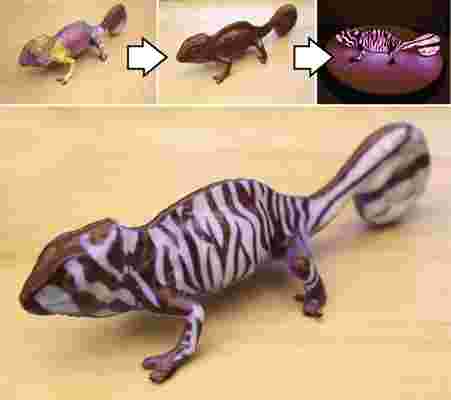
The team tested the system on a model car, a phone case, a shoe and a toy chameleon. The process of coloring the test objects took between 15 and 40 minutes. They also developed a user interface for creating special designs and patterns. Leopard-print shoes, anyone? When you want to change the color or pattern of the object, you simply put it back in the box, use the UV light to “erase” it, and start over.
Past projects involving reversible color-change technology have only been able to go from transparent to one color and back again. PhotoChromeleon is unique in that it can change between many colors.
Achieving this involved multidisciplinary collaboration, says CSAIL postdoctoral researcher Isabel Qamar. “The intersection between material science, optics and computer science, where expertise from all three areas have to be fused together, was the biggest challenge,” she says.
Qamar envisions a future where we can change clothes, shoes and accessories on a whim, make unique patterns on our cars, or even live in homes with reprogrammable furniture or walls. Goodbye, painting!
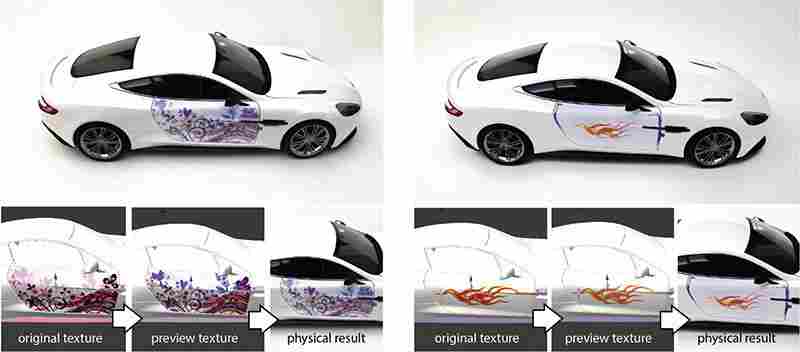
Warren Jasper, a professor of textile engineering at North Carolina State University, says people have been playing with color-change technology for decades, often for novelty products, such as heat-sensitive coffee mugs with patterns that appear when filled with coffee.
“It’s interesting, it’s a cool idea,” he says, of the MIT research. But for it to become commercially viable, the researchers will need to deal with how to keep the colors from fading in the sun, he says. And if they want to scale up, they’ll also need to find a more environmentally friendly alternative to the lacquer currently used to dissolve the photochromic dyes to make them sprayable. “People in the industry generally try to avoid those,” Jasper says.
Qamar says the team is indeed working on increasing the stability of the dyes so they last longer in outdoor light. They’re also looking at widening the range of colors achievable with the dye system—at the moment there’s no good way to make magenta, for example. Ultimately, the researchers are interested in experimenting with larger-scale applications where the dyes could be used directly in the manufacturing process.
So for now you’re still stuck choosing between those blue shoes and the brown ones. But in the future, the leopard print might be as easy as flicking on a light switch.
These Wild Sculptures Could Bring Sustainable Energy to the Desert
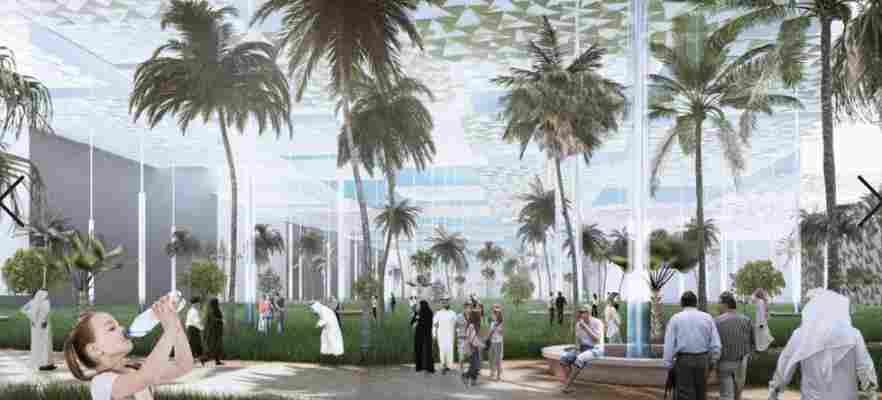
The average high in Abu Dhabi this time of year is nearly 105 degrees. That’s why much of life in the capital of the United Arab Emirates revolves around indoor shopping malls, with their cocoons of artificially chilled air. But imagine walking through an outdoor park beneath a shaded canopy, a light mist cooling your skin. As day turns to night, the light passing through the canopy’s geometric opening makes you feel like you’re strolling beneath the Milky Way.
This canopy concept, designed by New York architect Sunggi Park, is called Starlit Stratus. It’s the winner of a contest sponsored by the Land Art Generator Initiative (LAGI) , an organization looking to show that “renewable energy can be beautiful.” Since 2010, LAGI has been hosting a biannual contest for energy-generating public art. Previous contests have been held in places as far afield as Copenhagen, Santa Monica and Melbourne.
This year’s contest took place in Masdar City , a master-planned area within Abu Dhabi that originally aimed to become the world’s first “zero-carbon city.” Though Masdar City has yet to achieve its ambitious goals —it’s still largely empty, and its greenhouse gas emissions are drastically higher than originally planned—the desert provided an inspiring and challenging backdrop for the contest.
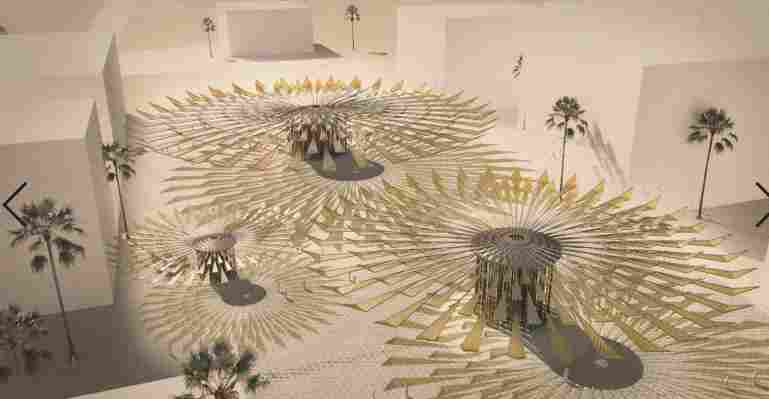
“The local climate presented opportunities for solar energy production and the integration of passive cooling strategies to make a comfortable environment year-round,” say LAGI’s founding directors Elizabeth Monoian and Robert Ferry in an email.
Park’s entry was inspired by origami tessellations. It’s composed of triangular solar panels to generate energy during the day and triangles of fabric that can be unfolded at night. It’s set on telescoping columns to allow for height adjustments, so it can capture the shade as the sun moves across the sky. Excess energy accumulated by the solar panels is used to collect moisture from the air, which can be stored as drinking water or used to provide a cooling mist.
“What impressed the judges about this project is the pragmatic approach to maximizing solar surface area in a manner that radically and dynamically transforms public space,” say Monoian and Ferry.
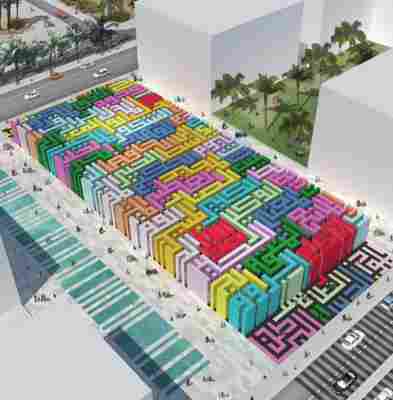
Park first learned origami as a kindergartener. “I loved the fact that a thin paper could turn into any geometry,” he says. “[The] origami that I learned when I was a kid influenced the LAGI competition.”
For their win, Park and his team will receive a cash prize of $40,000.
"I never expected I'd win this competition," Park says. "I feel honored and grateful."
The second-place winner was a project called Sun Flower, from Ricardo Solar Lezama, Viktoriya Kovaleva and Armando Solar of San Jose, California. It’s an enormous abstract flower sculpture with solar panel “petals” open in the day to collect energy and provide shade. At sunset, the petals gently close, their weight generating more energy. This energy illuminates the sculpture through the night like a giant lantern.
Other projects include a solar paneled sundial, a solar panel-topped labyrinth, and a rainbow-colored canopy to provide the city streets with colorful shade. One project uses house-size spheres painted with Vantablack (a material that absorbs 99.96 percent of visible light) to absorb sunlight. When night falls, the stored solar energy is used to inflate an even bigger white sphere that serves an event venue or communal gathering space. Many of the projects took inspiration from Emirati culture—one incorporates calligraphy, another plays with the concept of the desert oasis, while another features enormous “falcon eggs" made of solar panels, a nod to the national bird.
Monoian and Ferry hope to turn many of LAGI’s 1,000-plus entries into reality. Several are currently in progress, they say.
“We hope that LAGI can inspire people and instill a sense of desire and wonder for a new and better world that has drawn down carbon emissions to zero—to see what that world looks like and imagine themselves there,” they say. “After all, that is the world we must create for ourselves by 2050 at the very latest.”
